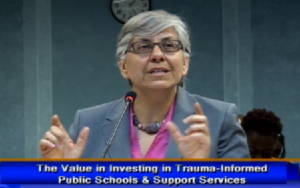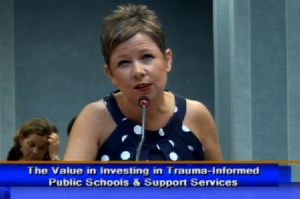Two-and-a-half years ago, a school administrator confronted District of Columbia Councilmember David Grosso with a stark and surprising reality when he visited the Walker-Jones Education Campus to learn about a literacy intervention program. At the end of the visit, the school official delayed Grosso’s departure to make one additional point: Something must be done to address the fact that over 40% of all DC students have experienced trauma—a “jaw-dropping” number, according to Grosso.
This year Grosso became chair of the Education Committee and has made trauma, mental health, and school discipline his top priorities. In preparation for budget discussions ahead, Grosso held a roundtable hearing on June 23, “The Value in Investing in Trauma-Informed Public Schools and Support Services.” About 30 people testified during the 3.5-hour hearing, including local officials, child advocacy and healthcare organizations, teachers, therapists, social workers, and others.

Judith Sandalow, the executive director of the DC Children’s Law Center (CLC), presented testimony based largely on the center’s report, Addressing Childhood Trauma in DC Schools, released on the day of the hearing. Coverage in the Washington Post (Trauma is hidden cause of academic struggles for many in DC, report finds) and other media featured the report’s findings and recommendations. Sandalow’s testimony highlighted the need for district-wide trauma-informed schools and services, saying implementation of these policies and practices have been piecemeal and not available to all of those who need them. A central recommendation contained in the report is to address this fragmentation and lack of coordination. One approach is to create a position to coordinate the schools’ efforts to become trauma-informed.
Both Sandalow and Chaz Kohlreiser, a therapist for the Wendt Center for Loss and Healing, described dramatic trauma histories of students who have benefited from attending DC schools that know how to help students who have experienced trauma. In a Huffington Post blog, Sandalow described “Janice” who had been sexually assaulted and had trouble feeling safe going to school. CLC worked to have her transferred to another school with onsite counseling and school personnel who helped her feel safer in the new school environment.

In his testimony, Kohlreiser presented two case studies illustrating how children who had experienced trauma in the form of violence and abuse are benefiting from enrollment in trauma-informed schools. One young student took on a “super-Ninja” persona, seeing danger everywhere and fearing everyone after he witnessed his father being shot to death by three men. A second student experienced sexual abuse by her father, who later died by suicide, and also lost two uncles to gun violence. He described her as being exhausted, having no more tears, and struggling to avoid expulsion from school. Because these two students are in trauma-informed schools, they found school personnel—including teachers, counselors, and janitors—whom they relate to and who can help with difficult situations during the day.
In a telephone conversation after the hearing, Education Committee Director Christina Henderson described a process where the all of the testimony and other information will be examined over the summer and in-depth conversations with agency partners will be held. This will lead to recommendations for projects and funding. She said it will take time to digest all of the information on promising programs such as the Wendt Center’s Resilient Scholars that provides school and community-based counseling, Turning the Page that trains teachers and staff to engage parents, and the training—now voluntary—being done by the superintendent of education.
Henderson and others involved in the hearing talked about the importance of creating an environment of trust and safety in schools and training everyone, including “the lunch lady and the janitor,” in what being trauma-informed means. Henderson specifically talked about the need to work with families and to coordinate with community services to ensure that parents and other caregivers are able to access what they need in one location.
Community characteristics such as rates of crime and homelessness should be considered in the development of trauma programs in individual schools, but, according to Henderson, district-wide policies and programs make more sense than targeted approaches because families in DC have a wide choice of school options, including public and charter schools.
Several people who testified noted how trauma-informed policies benefit everyone—teachers and other school personnel who have experienced trauma themselves or have difficulty knowing how to respond effectively to children in distress (including how not to take certain behaviors personally), students who are dealing with a temporary but difficult situations, as well as those who are experiencing toxic stress as a result of situations in the home and/or community.
The issue of screening for trauma was raised early in the hearing by Michelle Palmer, executive director of the Wendt Center for Loss and Healing. She sees value in universal screening, recalling scoliosis screening done when she was a young student and asked: “Why not have a trauma screen?” The quiet kid—not just the child acting out—may be experiencing trauma.

Palmer told a story about her own childhood when she was in the car with her mother who accidently hit and killed a young boy. No one in her school asked how she was doing and her mental health and grades declined as a result of the experience. She suffered more than she might have if those around her knew how this traumatic event could impact her and knew how to respond. Her testimony also described the neurobiology of toxic stress and the link between trauma and learning.
 Michael Lamb, executive director for Turnaround for Children, resonated with the stories told by Kohlreiser about students who have experienced toxic stress. Turnaround operates in 15 schools in New York City, Newark, NJ, and the District of Columbia, where they provide year-round counseling and training in trauma-informed practices.
Michael Lamb, executive director for Turnaround for Children, resonated with the stories told by Kohlreiser about students who have experienced toxic stress. Turnaround operates in 15 schools in New York City, Newark, NJ, and the District of Columbia, where they provide year-round counseling and training in trauma-informed practices.
“Schools like Walker-Jones and Orr have begun to prioritize student support and mental health, and it’s stopping the school to prison pipeline in its tracks,” said Lamb. “Just since 2012-13, the suspension rate at Walker-Jones has decreased by 75%; at Orr, by 71%. Change can happen.”
The Council demonstrated an interest in best practices in other cities and states (reflecting the unique status of DC as a city that also functions as a state), and has looked to Massachusetts, Washington State, San Francisco, and other cities for trauma-informed school policies and programs. Testimony by Sherry Peters of Georgetown University and Judith Sandalow of CLC highlighted the case studies of successful implementation of trauma-informed schools, citing reports on ACEsTooHigh.com. The CLC report included links to stories written by Jane Stevens and commissioned by The California Endowment, and the Georgetown University testimony mentioned ACEsConnection.com as a resource for trauma-informed, resilience-building practices, and noted that the new group for the DC region is on the site. The DC-area trauma-informed initiative participated in an ACEs Connection/Kennedy Forum screening in May of Paper Tigers, a documentary about Lincoln High School in Walla Walla, WA.
Turnaround’s Lamb provided a good takeaway for the hearing: “One out of six of our students will show up for school on August 24 with a backpack full of experiences that have locked them in ‘fight or flight’ mode…students who have experienced trauma and [who are] not getting the services they need, and thus the ‘school-to-prison’ pipeline begins.”
By addressing what’s in the backpack, he said, trauma-informed schools reduce suspensions and expulsions, stop the flow to prison that begins in childhood, and create a safe place for kids to learn and be successful.
Written By Elizabeth Prewitt
Washington, DC, City Council Education Committee probes how trauma-informed schools can help students was originally published @ ACEs Too High » Elizabeth Prewitt and has been syndicated with permission.
Our authors want to hear from you! Click to leave a comment
Related Posts



